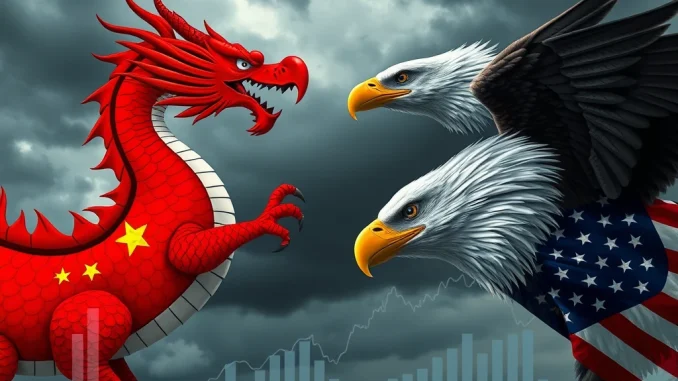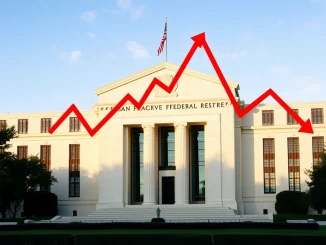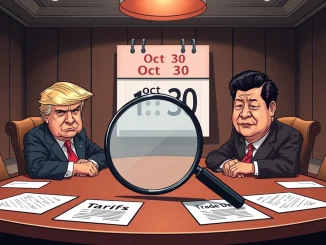
Hold onto your hats, crypto enthusiasts! Just when you thought the market winds were settling, a fresh gust of uncertainty is blowing in from the East. News just broke: China is set to slap a hefty 34% tariff on imports of U.S. goods. This isn’t just a minor trade skirmish; it’s a significant escalation that could send ripples across global markets, including our beloved crypto sphere. Let’s dive into what this means and why it should be on your radar.
Breaking Down the China Tariffs News
According to a recent alert from Watcher.Guru on X (formerly Twitter), China’s response to ongoing trade tensions with the United States is taking a decisive turn. The announcement of a 34% tariff increase is not just a number; it represents a clear message from Beijing and a potential shift in the global economic landscape.
Here’s a quick rundown of what we know:
- The News: China will impose an additional 34% tariff on selected U.S. goods.
- Source: Reported by Watcher.Guru, a well-known source for market updates, via their X platform.
- Impact: This move is expected to increase the cost of U.S. goods in China, potentially impacting various sectors and trade balances.
But what exactly does a tariff mean in simple terms? Imagine it like this: if you’re buying something from another country, a tariff is like an extra tax added at the border. This tax makes imported goods more expensive, theoretically encouraging people to buy products made within their own country. In this case, China is making U.S. goods more expensive for Chinese consumers and businesses.
Why is This Economic Impact a Big Deal?
This tariff isn’t happening in a vacuum. It’s a significant development in the ongoing saga of US-China trade relations. To understand the potential magnitude, we need to look at the broader economic impact.
- Trade War Escalation: This could be seen as a direct retaliatory measure, potentially escalating the existing trade tensions into a full-blown trade war. No one wins in a trade war.
- Supply Chain Disruptions: Businesses that rely on goods traded between the U.S. and China may face increased costs and disruptions to their supply chains. This can lead to higher prices for consumers and reduced profits for companies.
- Market Volatility: News like this often triggers uncertainty in financial markets. Investors tend to become risk-averse, potentially leading to sell-offs in stocks and other assets perceived as risky. And yes, that can include cryptocurrencies in the short term.
- Global Growth Concerns: A major trade dispute between the world’s two largest economies can dampen global economic growth prospects. Reduced trade and increased costs can stifle economic activity worldwide.
For crypto investors, understanding these macroeconomic factors is crucial. While cryptocurrency is often touted as being independent of traditional markets, it’s not entirely immune to global economic shifts. Fear and uncertainty in traditional markets can spill over into the crypto space, sometimes creating buying opportunities, but also potentially leading to downturns.
How Could This Affect Global Markets, Including Crypto?
Now, let’s zoom in on how this global markets event could impact the cryptocurrency world. While the direct link might not be immediately obvious, the interconnected nature of global finance means that ripples in one area can certainly be felt in another.
- Risk-Off Sentiment: When traditional markets react negatively to trade news, investors often move towards perceived safe-haven assets. While gold and the US dollar are traditional safe havens, Bitcoin is increasingly being considered as a digital alternative. However, in times of immediate panic, even Bitcoin can experience sell-offs as investors liquidate assets across the board.
- USD Strength/Weakness: The US dollar’s reaction to this news will be critical. If investors perceive this as damaging to the US economy, the dollar could weaken. Conversely, if it’s seen as a sign of US resilience, the dollar might strengthen. Dollar movements often have inverse correlations with Bitcoin, although this relationship isn’t always consistent.
- Supply Chain and Inflation: Tariffs can contribute to inflation by increasing the cost of imported goods. Inflation is a key narrative driving some crypto investments, as Bitcoin is seen as a hedge against inflationary pressures. Increased tariffs could strengthen this narrative in the long run, but the immediate market reaction can be unpredictable.
- Geopolitical Uncertainty: Heightened geopolitical tensions generally increase uncertainty in all markets. Crypto markets, known for their volatility, can become even more turbulent in such times. Traders might become more cautious, leading to increased price swings.
It’s important to remember that the crypto market is also driven by its own internal dynamics – technological developments, regulatory news, adoption rates, and more. However, major global economic events like this tariff announcement add another layer of complexity and potential volatility.
Understanding the US Trade Context
To fully grasp the significance of these new US trade tariffs, it’s essential to understand the existing trade relationship between the United States and China. This isn’t an isolated incident; it’s a continuation of a long-standing trade dynamic.
- Trade Imbalance: For years, the US has had a significant trade deficit with China, meaning the US imports far more goods from China than it exports. This imbalance has been a source of friction.
- Intellectual Property and Trade Practices: The US has long accused China of unfair trade practices, including intellectual property theft and forced technology transfers. These accusations have fueled trade tensions.
- Previous Tariffs: The Trump administration initiated a series of tariffs on Chinese goods, leading to retaliatory tariffs from China on US goods. The current move appears to be a continuation or escalation of this pattern.
- Negotiations and Agreements: Despite the tariffs, there have been periods of trade negotiations and agreements between the two countries. However, a comprehensive resolution to the underlying trade disputes remains elusive.
This historical context helps us understand that the 34% tariff is not just a random number; it’s a calculated move within a larger geopolitical and economic strategy. It reflects the ongoing complex relationship between the world’s two largest economies.
Navigating the Potential Trade War Waters
The term “trade war” might sound dramatic, but it accurately describes a scenario of escalating tariffs and trade restrictions between major economies. Are we heading towards a full-scale trade war? It’s too early to say definitively, but the risk is certainly increasing.
Here’s what to consider regarding a potential trade war scenario:
| Scenario | Potential Impact | Crypto Market Implications |
|---|---|---|
| Escalating Tariffs | Further tariffs from both sides, impacting more goods and sectors. | Increased market volatility, potential risk-off sentiment. |
| Supply Chain Chaos | Significant disruptions to global supply chains, impacting businesses and consumers. | Inflationary pressures could strengthen the Bitcoin hedge narrative. |
| Economic Slowdown | Reduced global trade and investment, potentially leading to slower economic growth. | Uncertainty and fear could drive investors to seek alternative assets, including crypto, or lead to risk aversion. |
| Negotiated Resolution | Diplomatic efforts to de-escalate tensions and reach trade agreements. | Market relief rally, reduced volatility, potential for risk-on sentiment to return. |
It’s crucial to stay informed and monitor developments closely. Trade policy is dynamic, and things can change rapidly. For crypto investors, this means being prepared for potential market fluctuations and adjusting strategies as needed.
Actionable Insights for Crypto Investors
So, what should you do as a crypto investor in light of this news? Here are a few actionable insights:
- Stay Informed: Keep up-to-date with news and analysis on US-China trade relations and global market reactions. Reliable sources like financial news outlets and market analysis platforms are essential.
- Manage Risk: Be prepared for potential market volatility. Consider diversifying your portfolio and using risk management tools like stop-loss orders if appropriate for your trading strategy.
- Long-Term Perspective: Remember that crypto markets are inherently volatile, and macroeconomic events can amplify this. Maintain a long-term perspective and avoid making impulsive decisions based on short-term market swings.
- Watch for Opportunities: Market downturns can sometimes present buying opportunities for long-term investors. If you believe in the long-term potential of crypto, market dips triggered by external events could be a chance to accumulate assets at lower prices.
- Consider Stablecoins: In times of uncertainty, some investors may choose to temporarily move a portion of their portfolio into stablecoins to reduce exposure to volatility while remaining within the crypto ecosystem.
In Conclusion: Navigating the Trade Winds
China’s imposition of a 34% tariff on U.S. goods is a significant development that adds another layer of complexity to the global economic outlook. For cryptocurrency markets, this news introduces a fresh element of uncertainty and potential volatility. While the long-term impact remains to be seen, it’s crucial for crypto investors to stay informed, manage risk, and maintain a balanced perspective. The world of crypto is no stranger to volatility, and navigating these “trade winds” requires both caution and strategic thinking. Keep your eyes on the charts, stay informed, and be prepared to adapt as the situation unfolds. The crypto journey, like global trade, is rarely a straight line, but it’s always an adventure!



